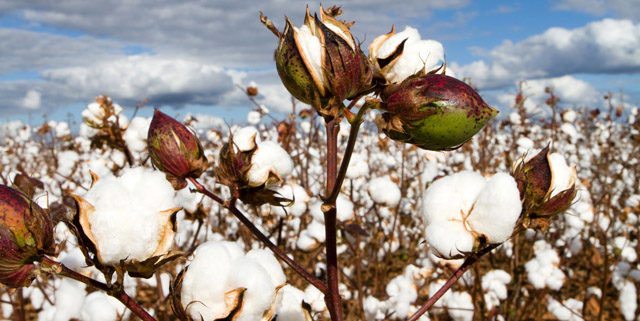RECENT PRICE MOVEMENT
Benchmark prices were flat or slightly higher over the past month.
- Prices for the May NY futures contract increased over past month, climbing from levels just below 70 cents/lb in mid-February to those near 74 cents/lb recently.
- The A Index also rose, increasing from values below 80 to those near 83 cents/lb.
- Chinese cotton prices represented by the CC Index (3128B) were essentially steady in both international and domestic terms (near 105 cents/lb or 15,500 RMB/ton).
- Indian spot prices (Shankar-6 quality) moved slightly higher in international (from 75 to 77 cents/lb) and domestic terms (from 41,700 to 42,400 INR/candy).
- Pakistani spot prices were steady at values equal to 76 cents/lb or 8,600 PKR/maund.
SUPPLY, DEMAND, & TRADE
This month’s USDA report featured little change. The global harvest estimate for 2018/19 rose 440,000 bales (to 118.9 million). The global mill-use estimate decreased 50,000 bales (essentially unchanged at 123.6 million). In combination, the slight increase in production and the slight decrease in consumption led the global ending stocks figure slightly higher (+590,000, to 76.1 million).
At the country-level, the largest increases to production figures included those for Brazil (+350,000, to 11.8 million) and Pakistan (+200,000, to 7.7 million). These gains were partially offset by a lower forecast for Australia (-100,000 bales, to 2.5 million). For mill-use, there were no changes over 100,000 bales.
The global trade estimate was marginally lowered (-130,000 bales, to 42.2 million). For imports, the largest change was for Indonesia (-100,000, to 3.6 million). For exports, the largest change was for Brazil (-200,000, to 6.0 million).
PRICE OUTLOOK
The USDA holds its annual outlook conference in late February every year. This meeting is where the USDA releases preliminary supply and demand estimates for an upcoming crop year. For 2019/20, the USDA expects there to be a healthy increase in production (+8.0 million bales, to 126.5 million). Mill-use is projected to increase at a rate near the long-term average next crop year (1.9 million bales, to 125.5 million).
Global consumption growth has been strong over the past several years and, if realized, the increase next crop year would result in a new record. This would end what has been a lost decade for cotton consumption, with it having taken more than ten years since effects stemming from the global financial crisis in 2008/09 and price spike in 2010/11 have allowed world cotton demand to surpass the record set in 2006/07.
Most of the global increase in production in 2019/20 is expected to come from the U.S. (+4.1 million bales, to 22.5 million). The increase in U.S. production is expected to result from an increase in harvested acres (USDA forecasting a 23% increase) rather than an increase in planted acres (USDA forecasting a 1% increase). In the U.S., the difference between planted and harvested acres comes from abandonment, when crop conditions are so bad that growers decide not to harvest. Last crop year, the early drought in West Texas (which commonly represents about one third of U.S. planted acreage) led to above average abandonment. Throughout the fall, West Texas had above average precipitation, and even though conditions have turned drier most recently, the severe drought that was in place a year ago has largely disappeared from the region. Less drought is widely believed to lead to lower abandonment and a large U.S. crop.
Outside the U.S., the largest increase in production in 2019/20 is expected to come from India (+1.5 million bales, to 28.5 million). Changes outside the U.S. and India are forecast to be comparatively small although increases are expected in all major producing countries (Pakistan +700,000 bales to 8.4 million, Brazil +600,000 to 12.4 million, China +500,000 to 28.0 million, Central Asia +400,000 to 4.6 million, and Turkey +300,000 to 4.0 million). From the rest of the world, combined production is projected to be mostly unchanged.
Early forecasts are helpful for providing a baseline set of assumptions, but the eventual reality the market will face in the coming crop year can be expected to differ. The principal questions facing the market now can be expected to drive the evolution of supply and demand figures into 2019/20.
Chief among these is the trade environment, and more specifically, the dispute between the U.S. and China. Discussion appears to have taken a more conciliatory tone recently, with the U.S. indefinitely postponing tariff increases that were scheduled to have gone into effect March 1st. Chinese reserve stocks are estimated to be near the level that the officials have indicated they would like to maintain (Cotlook estimates there are 12.4 million bales in reserves, a Chinese official indicated the government would like to maintain 11.5 million bales in reserves last fall). The USDA is currently forecasting China will import only 9.0 million bales in 2019/20. Stabilization of Chinese stocks implies Chinese imports will need to equal the Chinese production deficit (projected to be 13.3 million bales in 2019/20), suggesting the early USDA forecast could be too conservative.
Another major question for the market in 2019/20 is the macroeconomic situation. Since the second half of the 2018 calendar year, the outlook for global economic conditions has turned increasingly pessimistic. The extent to which this trend continues can be expected to influence demand.
Finally, as is always the case this time of year, the weather is a variable to watch. Generally, global growing conditions are anticipated to be better that in 2018/19. Whether that assumption, and whether other assumptions involving trade and the greater economic situation prove true or not can be expected to drive price direction.
